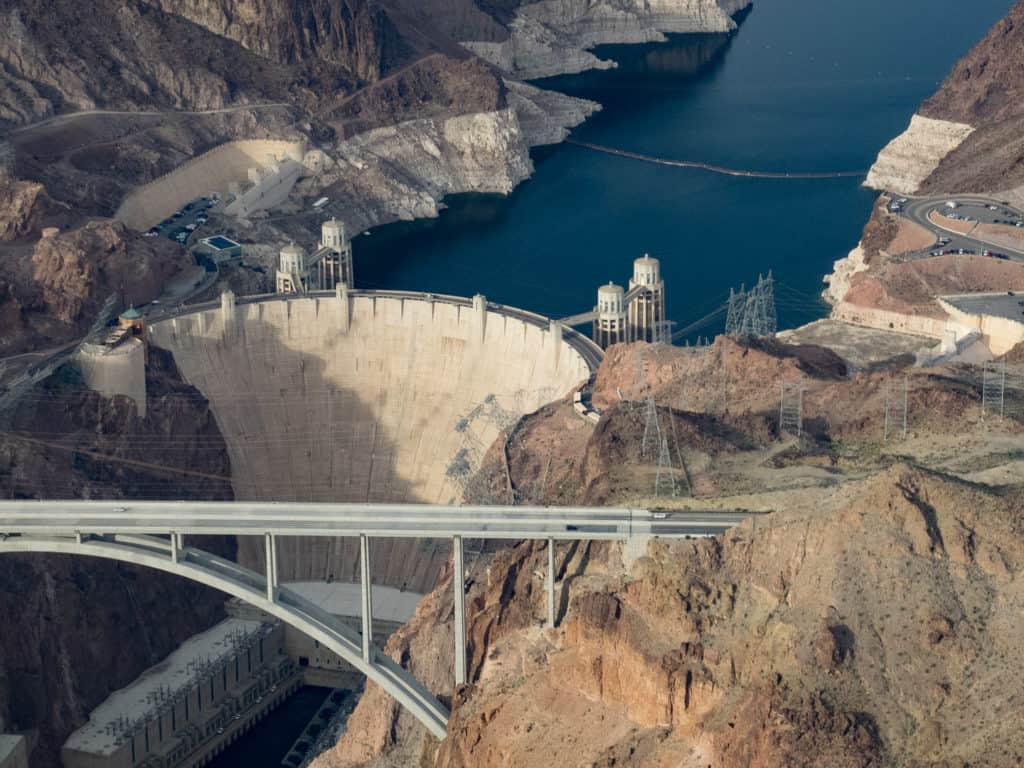With its amazing architecture and impressive design, the Hoover Dam attracts many visitors on its fine visual merits. The Dam forms the barrier holding in Lake Mead, the largest reservoir in the United States (and its own tourist attraction), and contributes a significant amount of hydroelectric power for Nevada, Arizona, and California. With concrete walls over 650 feet thick at the base, stretching over 720 feet high, it’s a massive construction that completely fills the Black Canyon at this particular junction.
Hoover Dam History & Background Information
Originally constructed as the Boulder Dam in the 1930s, this concrete arch-gravity dam is located 30 miles southeast of Las Vegas on the border of Arizona and Nevada in the Mojave Desert. It was subsequently renamed for President Herbert Hoover, who coordinated the 1922 Colorado River Compact as Secretary of Commerce, which determined that the water redirected by the dam would be distributed equally between the seven surrounding states. The Hoover Dam was declared a National Historic Landmark in 1985 and ranked among America’s Seven Modern Civil Engineering Wonders in 1994. The Hoover Dam was the largest structure of its kind in the world at the time of construction, and today remains an architectural marvel.

What’s at The Hoover Dam
About 7 million visitors flock to the Hoover Dam each year, enjoying explorations of the region through a variety of tours. While the most common excursions in the area are motor coach tours, helicopter tours are also a popular means of surveying this spectacular engineering marvel. Newer visitor facilities were constructed in the 1990s, offering amenities such as a substantial parking area and an outdoor café.
Owned and operated by the Bureau of Reclamation, these facilities also mark the departure point of a number of fascinating tours, including a detailed tour of the powerplant and an impressive excursion into some lesser-known areas inside Dam itself.
The powerplant tour features a number of guide-run presentations, special exhibits, and additional media that showcase the history and current status of the dam and its operations. Visitors will get to see many important locations on site, including the Penstock Viewing Platform, the Powerplant Generators, an additional observation deck, an exhibit gallery, Nevada and Arizona Spillways, and the Nevada Intake Towers.
The Hoover Dam tour also offers access to the fascinating Visitor Center and its interactive historical displays, as well as all of the sites on the powerplant tour. Additional sights available on this tour include the Inspection Galleries.
The powerplant tour runs about 30 minutes, while the Hoover Dam tour comes in at about an hour. Either tour is relatively inexpensive, and both provide excellent overviews of the history, architecture, and contemporary operations of the dam.
Tips for Visiting The Hoover Dam
- A favorite view of the dam is from the Pat Tilman Bridge.
- The visitor center parking lot costs $10, but travelers can park for free at the lots on the other side of the dam.
- Cars of a certain weight and class can drive over the dam, although you aren’t permitted to stop on the route.
- Those who wish to explore the region without paying for a tour can enjoy stunning exterior views of the dam (including the spillway channels and intake towers) from the parking lots and surrounding areas, or from the nearby Lakeview Overlook.
- Papillon and Grand Canyon Coaches run bus tours to the Hoover Dam as a stand alone tour or as part of a trip all the way to the Grand Canyon from Las Vegas.
- If you take a helicopter tour to the Grand Canyon from the Las Vegas area, you usually do a flyover for a brief but spectacular view of the Hoover Dam
- It takes approximately two hours to explore the dam fully (more if you go on a formal tour).